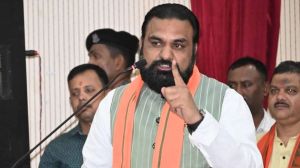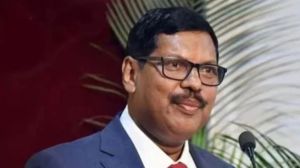South Block
They were once the favourites. Now the Dravidian constituents, particularly the DMK and the PMK, have become the cause of much embarrassment to the Congress-led United Progressive Alliance, writes Jaya Menon

The honeymoon seems to have ended and the endearments have dried up. Until the other day, Tamil Nadu Chief Minister and DMK president M Karunanidhi, hailed as the architect of a highly successful alliance down south, could make no mistake. Now, the Dravidian constituents, particularly the DMK, which leads the pack with 16 MPs, and the PMK (6 MPs), are proving the most troublesome, meddlesome, and downright embarrassing for the Congress-led United Progressive Alliance.
The latest in the bag of complaints is the Neyveli Lignite Corporation disinvestment which had a rather dramatic curtains-down yesterday. Apparently, there is deep resentment in the Congress ranks over the ‘‘double standards’’ of Karunanidhi, Congress president Sonia Gandhi’s favourite ally. While Prime Minister Dr Manmohan Singh buckled under pressure when the DMK chief threatened to pull out his nominees from the government, his arm-twisting is said to have chipped Congress-DMK relations.
Tamil Nadu Congress leaders point out that the DMK had not raised even a whimper of protest against the Centre’s disinvestment moves earlier. Since July 2004, soon after the UPA came to power, Union ministers Dayanidhi Maran and T R Baalu have, as members of the Cabinet Committee on Economic Affairs, gone along with all the CCEA’s decisions to offload stakes from profitable PSUs.
Whether it was divesting 5 per cent NTPC shares or proposals to sell five per cent equity in the Power Finance Corporation and 15 per cent in National Mineral development Corporation and the constitution of a National Investment Fund with money from the disinvestment drive, the DMK had given its vote of approval. While Karunanidhi attempted to shrug off responsibility for the NLC disinvestment decision, saying his two ministers had not attended the CCEA meeting concerned, Health Minister Anbumani Ramadoss (PMK) had attended the full cabinet meeting which followed immediately.
Unwilling to create rifts in the coalition, Karunanidhi had suggested that if disinvestment was inevitable, the 10 per cent NLC stakes could be sold to the workers. But with the workers’ unions, including the DMK-affiliated LPF, stridently opposing the proposal, the DMK chief quickly backtracked, joining the chorus for dropping the disinvestment move in toto.
If the NLC mess up took some of that sheen off the much flaunted Congress-DMK bonhomie, then the ugly AIIMS controversy exposed a few chinks too. The party grapevine had it that Anbumani had been inspired to fight the anti-reservationists by none other than his own father for whom the reservation issue is a pet theme.
Dr S Ramadoss, the PMK founder, had risen to prominence on the vanguard of reservations for the Vanniyar community which hails him as their leader. It was during M G Ramachandran’s tenure as CM that Ramadoss had managed to get the community the MBC (Most Backward Caste) status. The community’s gratitude helped his Vanniyar Sangam evolve into a political party. Anbumani apparently had been pushing his party’s agenda in New Delhi and AIIMS director Dr P Venugopal just happened to come in his way. Hence the need to axe him. With Karunanidhi providing the political backing, Anbumani got away with his decision, the most controversial yet.
But there are more blots from Tamil Nadu that have caused acute embarrassment to the UPA government. One of the most favourite themes of Jayalalithaa’s attack has been that Karunanidhi had openly promoted his family members, and ensured that Murasoli Maran and later his son, 39-year-old Dayanidhi Maran, were accommodated in the Union Cabinet. This time not only did he get junior Maran a berth but also the Communication portfolio, vital for his family flagship, the Sun TV Group.
The induction of a political novice like Maran as minister for Communications and IT in the Union Cabinet had caused ripples in political circles. It was pointed out that his appointment would amount to a conflict of interest. It was then that Sumangali Cable Vision, a powerful multi-system operator with virtual control of the cable network in Tamil Nadu, had challenged TRAI’s order withdrawing CAS in the Madras High Court.
With the Communications Ministry coming under Maran and TRAI’s operations being a part of it, it did look like a serious conflict of interest. The AIADMK chief had time and again demanded that Maran be divested of the portfolio, but coalition politics has saved the young DMK minister.
Another allegation that dominated the recently concluded Tamil Nadu Assembly election was that Dayanidhi Maran had arm-twisted Tata chairman Ratan Tata into selling shares of his DTH unit to the Sun TV group. Maran not only dismissed the charge as ‘‘a lie inspired by personal vendetta and jealousy,’’ considering his ‘‘increasing popularity as a dynamic political figure’’, but he also made up for his image loss by having Tata meet him, making it appear that great cordiality existed between the two.
IF the ministers from Tamil Nadu are giving the UPA Government a tough time, then Karunanidhi himself is seen as showing the way. The NLC drama is the second instance of muscle flexing by the veteran politician. In July 2004, soon after the Congress-led coalition came to power, Karunanidhi threatened to keep out of the government, accusing the Congress leadership of failing to keep to its commitment of surrendering some hefty portfolios to the DMK.
At a crowded press meet, the DMK chief read out the agreement reached between him and senior Congress leader Janardhan Reddy on portfolios to prove his point that the Congress was going back on its word. Karunanidhi relented after the PM ‘honoured’ his commitment, giving seven of his 16 party MPs heavyweight portfolios in the Union Cabinet.
While Karunanidhi is seen as being instrumental in cobbling up the formidable rainbow alliance which swept the Lok Sabha polls in 2004, the Congress lost four of the 40 seats from its kitty in Tamil Nadu and Union Territory of Pondicherry when MDMK’s Vaiko quit the DMK-led alliance before the Assembly polls. When Vaiko teamed up with the AIADMK’s Amma, Karunanidhi pressured the Congress to throw out the MDMK from the UPA.
For Prime Minister Singh, keeping a firm hold on the government despite the tugs and pulls from his meddling allies, particularly those from Tamil Nadu, is proving to be his toughest brief.
Past Imperfect
July 2004
Karunanidhi steps up pressure on Congress to part with two important portfolios promised to him — Shipping for T.R. Baalu and Finance and Revenue for S.S. Palanimanickam. Karunanidhi says his party will not be part of the government until Congress gives in to his demand and discloses the details of the agreement to the media. Congress concedes, 7 DMK nominees are inducted as Union Ministers
Jan/Feb 2006
Union Environment Minister A Raja, turns deaf ear to protests from activists that the controversial French warship Clemenceau, containing more than 500 tonnes of asbestos, heading for the ship-breaking yard at Alang in Gujarat, should not be allowed into Indian waters. The French Government finally takes back the ship and activists demand Raja’s resignation on moral grounds.
May 2006
The opposition in Tamil Nadu led by AIADMK chief J Jayalalithaa, alleges that Union Minister Dayanidhi Maran had arm-twisted Tatas chairman Ratan Tata to force him to part with shares of his DTH unit for the Sun TV group managed by his brother, Kalanidhi Maran. Maran dismisses the charge and gets Tata to meet him for discussions on various projects for Tamil Nadu
July 2006
Union Health Minister Anbumani Ramadoss sacks AIIMS director Dr P Venugopal, kicking off a major controversy. The action is seen as part of his own party’s (PMK) reservation agenda
July 2006
Karunanidhi arm-twists Prime Minister Manmohan Singh to drop NLC disinvestment plans, threatening to pull out of the government



- 01
- 02
- 03
- 04
- 05




























